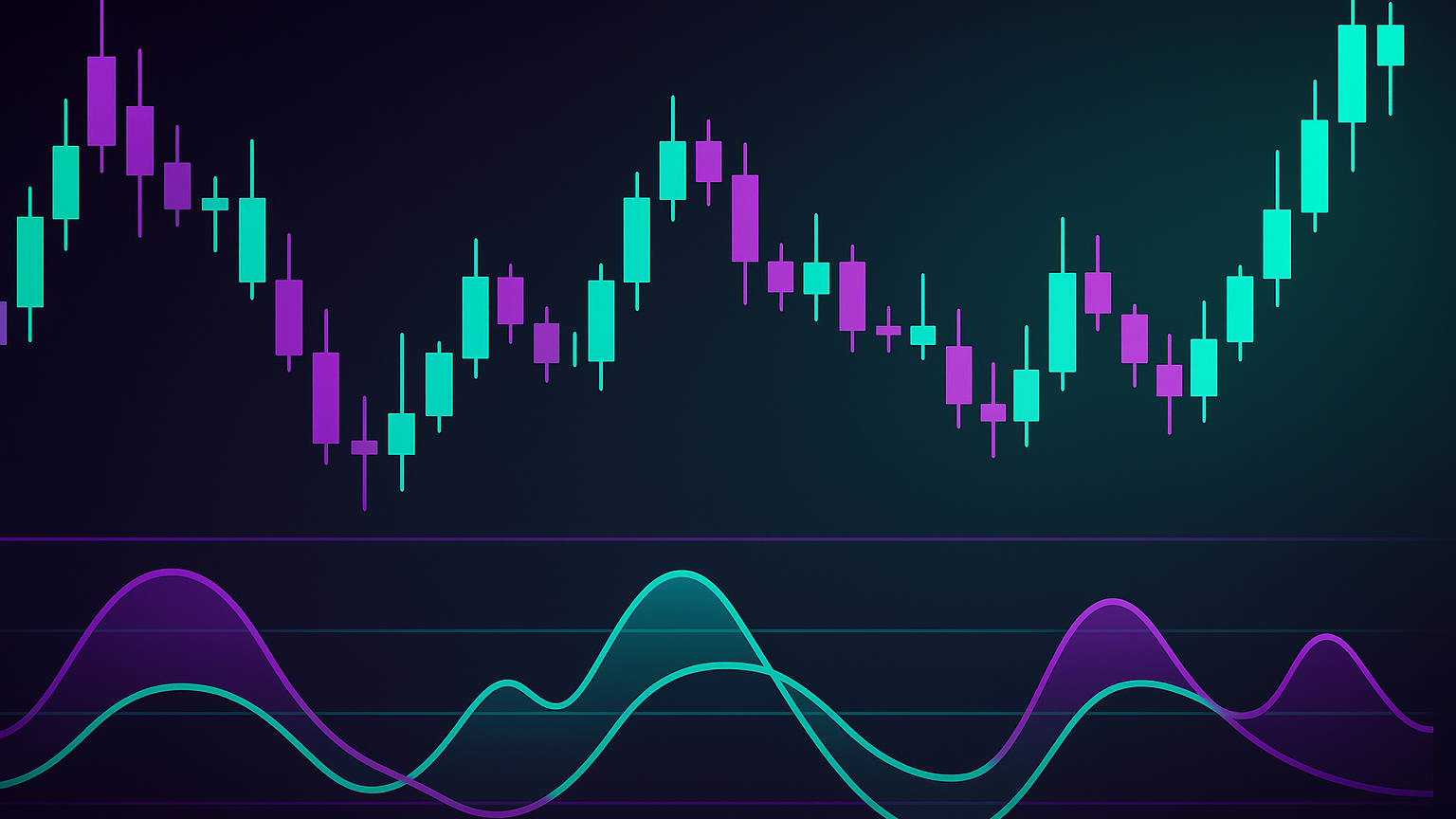Explore the Smoothed Moving Average (SMMA) for clearer trend analysis, fewer false signals, and effective trading strategies.
The Smoothed Moving Average (SMMA) is a refined moving average that helps traders identify trends by filtering out short-term market noise. Unlike SMA and EMA, SMMA uses extended smoothing, creating a steadier trend line that is less reactive to sudden price changes. This makes it effective for long-term trend analysis, reducing false signals and helping traders make more informed decisions.
Key Takeaways:
- Smoother Trend Line: SMMA provides a stable view of market trends by reducing the impact of short-term fluctuations.
- Fewer False Signals: Its gradual adjustments minimize misleading signals, especially in volatile markets.
- Best for Long-Term Analysis: Ideal for swing and position traders focusing on broader trends.
- Limitations: Slower to react in fast-moving markets and less effective in range-bound conditions (what “range-bound” means).
If you're looking for a reliable indicator to cut through market noise and focus on sustainable trends, SMMA is worth considering. Pairing it with tools like RSI, volume indicators, or LuxAlgo indicators on TradingView can further enhance its effectiveness. Note: SMMA is not a LuxAlgo indicator; it’s a general moving average that can be used alongside LuxAlgo’s tools to inform and test strategies.
Trading Strategies With The Smoothed Moving Average (SMMA)
How SMMA Works: Calculation and Usage
The Smoothed Moving Average blends a solid mathematical approach with practical use in trading. Its smoothing effect helps traders uncover meaningful trends in market data.
SMMA Calculation Process
SMMA stands apart from traditional moving averages due to how it handles historical data. Unlike other methods that drop older prices from the equation, SMMA keeps them in the calculation—though their influence gradually diminishes over time (TradingView help). This approach ensures that all available data contributes to the average, creating a smoother result. For a moving-average perspective from LuxAlgo’s Library, see the Moving Averages Proximity Oscillator, which evaluates price vs. multiple MAs.
When new price data is added, SMMA adjusts by reducing the weight of older prices rather than discarding them. This smoothing process makes SMMA slower to react to sudden price changes compared to faster moving averages. As a result, it filters out short-term market noise, providing a clearer picture of the overall trend.
With the calculation process explained, let’s explore how traders use SMMA to guide their decisions.
Reading SMMA in Trading
SMMA serves as a reliable indicator of market momentum. When the SMMA line rises, it reflects bullish momentum; when it falls, it signals bearish pressure. By smoothing out short-term fluctuations, it offers a broader perspective on market trends. For additional context on sentiment and trend gauging, explore Market Sentiment Technicals.
The slope of the SMMA provides additional insights:
- A steep upward slope suggests strong bullish momentum.
- A gentle upward slope indicates moderate positive momentum.
- A steep downward slope points to strong bearish momentum.
- A gradual decline signals weaker selling pressure.
Trading above the SMMA generally reflects bullish sentiment, while trading below it suggests bearish conditions. Additionally, when the price deviates significantly from the SMMA, it may indicate that the market is overextended and could be due for a correction.
Traders also pay attention to shifts in the SMMA's direction. For instance, if the line starts to flatten after a prolonged trend, it could hint that the trend is losing strength—potentially signaling an upcoming reversal. This makes SMMA a valuable tool for spotting early signs of changing market dynamics.
Main Advantages of SMMA for Trend Analysis
The Smoothed Moving Average (SMMA) is a powerful tool for identifying trends and cutting through market noise.
Benefits of Using SMMA
One of the standout benefits of SMMA is noise reduction. Markets are often riddled with random price movements that can confuse traders. SMMA addresses this by applying cumulative historical weighting, which filters out short-term fluctuations. The result? A smoother line that highlights the true direction of the trend without the distractions of erratic price changes.
Another key benefit is enhanced trend confirmation. Unlike other indicators that react quickly to price changes, SMMA adjusts more gradually. This slower response helps traders avoid reacting to false breakouts or premature trend reversals. When SMMA shifts direction, it’s more likely to indicate a meaningful change in market sentiment rather than a fleeting price movement.
SMMA also leads to fewer false signals. Thanks to its smoothing properties, SMMA minimizes whipsaws—those frustrating moments when an indicator gives misleading signals. By generating more reliable signals, SMMA allows traders to stay calm during minor market corrections that don’t disrupt the overall trend. Compare with Signal Moving Average, designed to reduce whipsaws in ranging markets.
Better risk management is another advantage. The smoother trend line provided by SMMA enables traders to set more precise stop-loss levels and position sizes. If you’re newer to order placement, here’s a concise primer on stop-loss orders. Since SMMA doesn’t react to every small price move, it helps decisions hinge on clearer, more consistent trends.
Lastly, SMMA offers a long-term perspective. By focusing on the broader trend and filtering out daily market noise, it’s particularly useful for swing and position traders. This helps distinguish between temporary setbacks and genuine reversals. For structure-aware S/R, see Support & Resistance Dynamic.
SMMA vs. SMA and EMA Comparison
To choose the right moving average for your trading strategy, it’s helpful to compare SMMA with the Simple Moving Average (SMA context) and Exponential Moving Average (EMA):
| Feature | SMMA | SMA | EMA |
|---|---|---|---|
| Smoothing Effectiveness | Highest — filters most noise | Moderate — some smoothing | Lower — more responsive to recent prices |
| Responsiveness to Price Changes | Slowest — gradual adjustments | Moderate — balanced response | Fastest — quick reactions |
| Signal Reliability | Highest — fewer false signals | Moderate — balanced accuracy | Lower — more frequent signals |
| Best Use Cases | Long-term trend analysis, volatile markets | General trend identification, beginners | Short-term trading, quick entries/exits |
| Lag Time | Highest — delayed signals | Moderate — some delay | Lowest — minimal delay |
SMMA stands out in volatile markets, where its ability to reduce noise and deliver stable signals is invaluable. Its slower adjustments make it a favorite for traders who prioritize accuracy and prefer fewer, higher-quality signals over frequent trades.
SMA strikes a balance between smoothing and responsiveness, making it a versatile option for traders who value simplicity. However, it can falter during high volatility. The Moving Average Converging indicator shows how adaptive smoothing can respond differently to trend changes.
EMA is about speed. It reacts quickly—useful for day traders and scalpers—but can increase false signals. If you need confirmation tools around trend context, Signals & Overlays™ provides overlays and signals that pair well with moving averages.
Using SMMA in Trading Strategies
The SMMA adds stability to trading strategies, making it valuable for trend following, crossovers, and dynamic support/resistance. Its ability to filter short-term noise helps here.
Trend-Following with SMMA
SMMA is often used as a filter to determine trend direction. When price stays above the SMMA line, it suggests an uptrend; below suggests a downtrend. For volume-aware context, LuxAlgo’s Liquidity Levels can help corroborate demand/supply zones.
In an uptrend, consider buying when price pulls back toward the SMMA line but doesn’t close below it. Because SMMA reacts slowly, it’s wise to wait for clear confirmation. On higher timeframes, SMMA reduces the noise of daily moves. A short primer on multi-timeframe use is here.
Using multiple timeframes can enhance trend analysis: a weekly baseline plus a daily trigger often improves timing. When both align, you gain stronger confirmation for long positions. For exits, see PAC Backtester exit rules.
Crossover Strategies
SMMA crossovers are great for entries and exits. Unlike faster moving averages, SMMA crossovers tend to be more selective. For example, a price cross above SMMA after consolidation can flag an emerging uptrend. A helpful companion is the Signal Moving Average, built to reduce whipsaws during ranges.
For exits, watch for price crossing back through the SMMA in trend. Because SMMA avoids reacting to tiny moves, signals arrive with more context. For dual-average logic, a dual-SMMA style setup (short vs. long length) can further refine the bias. Use LuxAlgo’s testing resources to try parameters: AI Backtesting Assistant and optimizer docs.
Dynamic Support and Resistance
SMMA often behaves like dynamic support or resistance. Pullbacks toward the SMMA can offer lower-risk entries; in downtrends, rallies into the SMMA can offer shorts. Manage risk with stops sized to structure—more on TP/SL placement.
Volume context matters too. When price approaches the SMMA with high activity, inflections are likelier. If you use volatility cues, the CME’s methodology for implied volatility indices provides useful background on how markets price risk (CME CVOL primer).
Using SMMA Analysis with LuxAlgo Tools
LuxAlgo provides powerful trading tools on TradingView that complement SMMA analysis. Whether you're a beginner or an experienced trader, these indicators simplify SMMA-based workflows while adding deeper insights. Reminder: SMMA itself isn’t provided by LuxAlgo; you can use it alongside LuxAlgo tools and then test rules with AI Backtesting.
Accessing SMMA via LuxAlgo
LuxAlgo’s free Library includes hundreds of indicators that work alongside SMMA on TradingView, NinjaTrader, MetaTrader, and Thinkorswim. For moving-average and S/R context, try Nadaraya–Watson Smoothers, NW Envelope, and Support & Resistance Dynamic.
While the free Library offers standard functionality, LuxAlgo plans unlock exclusive tools. The Premium plan ($39.99/mo) provides Signals & Overlays and Oscillator Matrix tools on TradingView; Ultimate ($59.99/mo) adds the AI Backtesting Assistant platform for strategy discovery and testing.
Improving SMMA Strategies with LuxAlgo Tools
LuxAlgo equips traders with tools to refine SMMA workflows:
- AI Backtesting Assistant: Test SMMA rules across tickers and timeframes. Explore entry/exit logic, SMMA periods, and risk settings.
- Signals & Overlays (S&O) Toolkit: Layer confirmation/contrarian signals and overlays around your SMMA bias.
- Screeners: Scan for SMMA-based conditions (e.g., price crossing SMMA) using the S&O Screener docs (filtering guide).
- Backtesters: Validate crossover and S/R methods. See optimization for parameter search.
LuxAlgo Benefits for SMMA Users
- Custom Alerts: Set alerts on SMMA touches/crosses using toolkit alerting (alerts overview).
- Live Help: 24/7 support for setup and strategy questions.
- Community: Share SMMA strategies and get feedback.
Plans recap: Free ($0) includes the Library; Premium $39.99/mo adds advanced TradingView features; Ultimate $59.99/mo includes AI Backtesting.
SMMA Limitations and Best Practices
SMMA Limitations
Lag in Fast-Moving Markets: SMMA’s smoothing reacts more slowly to sudden changes. In fast markets, this can delay entries/exits.
Less Responsive to Short-Term Moves: Great for long-term bias but not ideal for scalping.
Struggles in Range-Bound Markets: Consolidations can produce whipsaws—here a range strategy (buy support/sell resistance) is often better (range trading basics).
Choosing Periods: There’s no universal “best” length; tune to asset/volatility. Consider longer lengths for smoother bias.
Best Practices for SMMA Use
Combine with Leading Indicators: Pair SMMA with momentum/volume. For example, Market Sentiment Technicals plus SMMA can confirm shifts. If you’re sizing risk, review TP/SL guidance and a primer on stop orders.
Adjust Periods by Market Regime: Shorter SMMA (10–20) for volatile regimes; longer (50–100) for smoother trends. Tools like SuperTrend Oscillator can add context.
Use Multi-Timeframe Analysis: Align higher-timeframe SMMA with lower-timeframe triggers. Quick overview: MTF walkthrough.
Have a Plan for Sideways Markets: Define consolidation criteria (e.g., price within ±2% of SMMA). Consider S/R tools like S&R Levels with Breaks.
Use SMMA as a Supporting Tool: SMMA crossovers shouldn’t be your only trigger; confirm with overlays (e.g., S&O) or structure.
Incorporate Risk Management: Place stops beyond logical structure rather than fixed %s; consider the distance to your SMMA or S/R level.
Review and Refine: Track outcomes and iterate. When ready, validate in AI Backtesting and the optimizer.
Conclusion
The Smoothed Moving Average offers a consistent trend line that effectively filters out market noise. Its recursive update blends historical data with recent prices, creating a smooth and steady line that focuses on sustainable trends while avoiding misleading short-term fluctuations.
When paired with LuxAlgo’s indicators, SMMA becomes even more effective. Price Action Concepts maps structure, Signals & Overlays supplies confirmations, and Oscillator Matrix adds reversal logic. LuxAlgo’s AI Backtesting Assistant then helps fine-tune periods and entries across markets and timeframes. Again, SMMA is not part of LuxAlgo; it’s a widely used moving average that can be combined with LuxAlgo resources for strategy design and testing.
SMMA isn’t perfect—fast markets and tight ranges can dull its edge. But with sensible periods, multi-timeframe alignment, and structure-aware risk, it provides a clearer perspective for technical analysis.
FAQs
How does the Smoothed Moving Average (SMMA) reduce market noise compared to the Simple Moving Average (SMA) and Exponential Moving Average (EMA)?
The Smoothed Moving Average (SMMA) responds more slowly to price fluctuations, filtering out short-term noise so you can focus on the long-term trend. SMA is simpler but can lag; EMA is faster but can overreact. SMMA sits in the middle, emphasizing stability. For additional moving-average context, see LuxAlgo’s MAPO.
How can I effectively use the Smoothed Moving Average (SMMA) in my trading strategy, especially during volatile or range-bound market conditions?
In volatile markets, combine SMMA with volume or confirmation overlays (e.g., S&O). In ranges, pair SMMA with structure tools and trade mean-reversion toward dynamic S&R. Keep stops just outside logical levels; here’s a refresher on stop orders.
How can LuxAlgo’s tools make the Smoothed Moving Average (SMMA) more effective for trading, and which features should traders focus on?
Use AI Backtesting to test SMMA periods and rules, S&O for confirmations, and structure indicators like Support & Resistance Dynamic to align with trend.
References
LuxAlgo Resources
- LuxAlgo Indicator Library
- AI Backtesting Assistant
- Trend Lines
- Moving Averages Proximity Oscillator
- Breakouts with Tests & Retests
- Market Sentiment Technicals
- Liquidity Levels
- Support & Resistance Dynamic
- Signal Moving Average
- Nadaraya–Watson Smoothers
- Nadaraya–Watson Envelope
- Signals & Overlays™
- Backtester (S&O) – Optimization
- Backtester (PAC) – Exit Rules
- Oscillator Matrix – Reversal Signals








